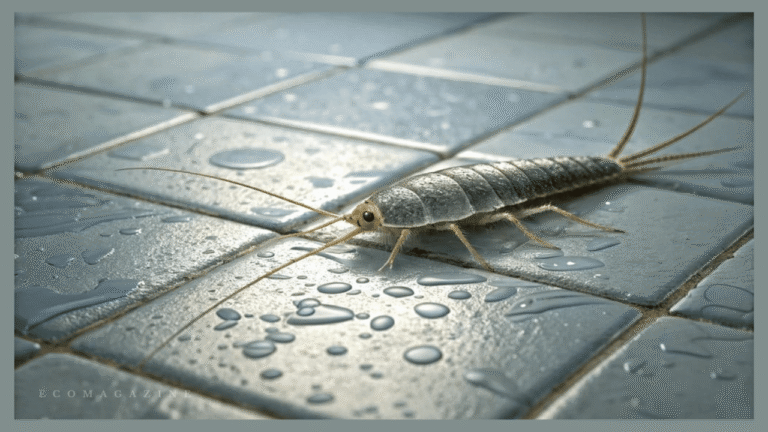Silverfish might seem harmless, but spotting them in your bathroom is a warning sign you shouldn’t ignore. These fast-moving, silver-grey insects thrive in damp, humid spaces — making bathrooms a perfect hideaway. Their presence doesn’t just mean a nuisance; it can also indicate hidden leaks, poor ventilation, excess moisture, and even potential damage to your home and belongings.
If left untreated, silverfish can damage paper, wallpaper, books, clothing, plaster, and even dry food items. They also leave behind droppings and shed skins that may trigger allergies. Acting early protects both your health and your home environment.
Why Bathrooms Attract Silverfish
Bathrooms provide everything silverfish love — moisture, warmth, darkness, and food sources.
- High humidity and dampness from daily showers, leaky pipes or poor ventilation make survival easy.
- Food sources include soap residue, dead skin cells, glue in bathroom products, toilet paper, cotton towels, and even mould.
- Easy access points such as cracks around pipes, skirting boards, tile gaps, extractor fans, or window frames allow them to enter and hide undetected.
If silverfish are appearing regularly, it often suggests a deeper moisture problem — something that could eventually lead to mould, mildew or structural damage.
(You may also link here to support moisture-related pest issues:
→ Moisture problems and bathroom pests like silverfish and cockroaches)
Are Silverfish Harmful?
Silverfish don’t bite or spread diseases. However, they can still cause problems:
- Damage to belongings — They feed on starch, cellulose and protein. That includes books, wallpaper paste, old photos, clothes, even dry foods like oats and flour.
- Food contamination — Silverfish can crawl into cupboards and contaminate dried food with droppings and shed skins.
- Allergic reactions — Some people experience skin irritation or respiratory allergies triggered by silverfish scales and droppings.
- Moisture warning sign — Their presence often suggests hidden leaks, dampness or condensation that could later cause mould or rot.
Signs of a Silverfish Infestation
You may have a silverfish problem if you notice:
✔ Tiny pepper-like droppings in cupboards, corners or window sills
✔ Shed skins that look like translucent flakes
✔ Yellowish stains on paper, wallpaper or fabrics
✔ Small holes or irregular scraping marks on books, cardboard boxes or clothing
✔ Live silverfish darting quickly along skirting boards, tiles or bathroom floors at night
How to Get Rid of Silverfish in Your Bathroom
To effectively get rid of silverfish, you must tackle both the insects and the conditions that allow them to thrive.
1. Reduce moisture — the most important step
- Use an extractor fan or keep windows open after baths/showers
- Repair leaks around sinks, toilets or pipes
- Wipe condensation from tiles and mirrors
- Use a dehumidifier in persistently damp bathrooms
2. Remove food sources
- Keep toothbrushes, cotton products and paper items stored in sealed containers
- Wipe away soap scum and product residue from surfaces
- Clean behind toilets, sinks and skirting where dust and dead skin cells build up
3. Block their entry points
- Seal cracks around pipework, tiles, skirting boards and window frames
- Fit covers over extractor fans and bathroom vents if gaps are visible
4. Use safe treatments
- Sprinkle diatomaceous earth or boric acid behind toilets and under sinks (keep away from pets and children)
- Place sticky traps near typical hiding spots
- Essential oils like lavender, cedarwood or peppermint can help repel them naturally
When to Call a Professional
If silverfish keep coming back, or you suspect they’re nesting behind walls, under flooring or spreading into other rooms, it’s time to seek specialist help.
Professional treatments don’t just remove silverfish — they address the root cause, whether that’s dampness, ventilation failure or hidden leaks.
For expert help in London and Essex, you can visit
👉 Silverfish Pest Control – Bugwise Pest Control
Prevention: Keeping Your Bathroom Silverfish-Free
- Ventilate after every shower or bath
- Fix leaks immediately
- Store toiletries, cleaning products and paper items in sealed containers
- Wipe down surfaces to avoid moisture build-up
- Inspect regularly — especially under sinks, behind toilets and in cupboard corners
Final Thoughts
Silverfish aren’t dangerous, but they are an early warning of moisture problems that could lead to bigger issues — mould, damage to property and pest infestations. By acting early, improving ventilation, sealing access points and keeping your bathroom dry, you can prevent silverfish from becoming a long-term problem.
If silverfish are already spreading or causing damage, booking a professional inspection is the safest option.
Author Bio
Mo Samir is the founder of Bugwise Pest Control, a BPCA-qualified pest management company serving homes and businesses across London and Essex. From bathroom silverfish to full-scale infestations, Bugwise delivers discreet, expert treatments with a focus on prevention, safety and honest advice.


